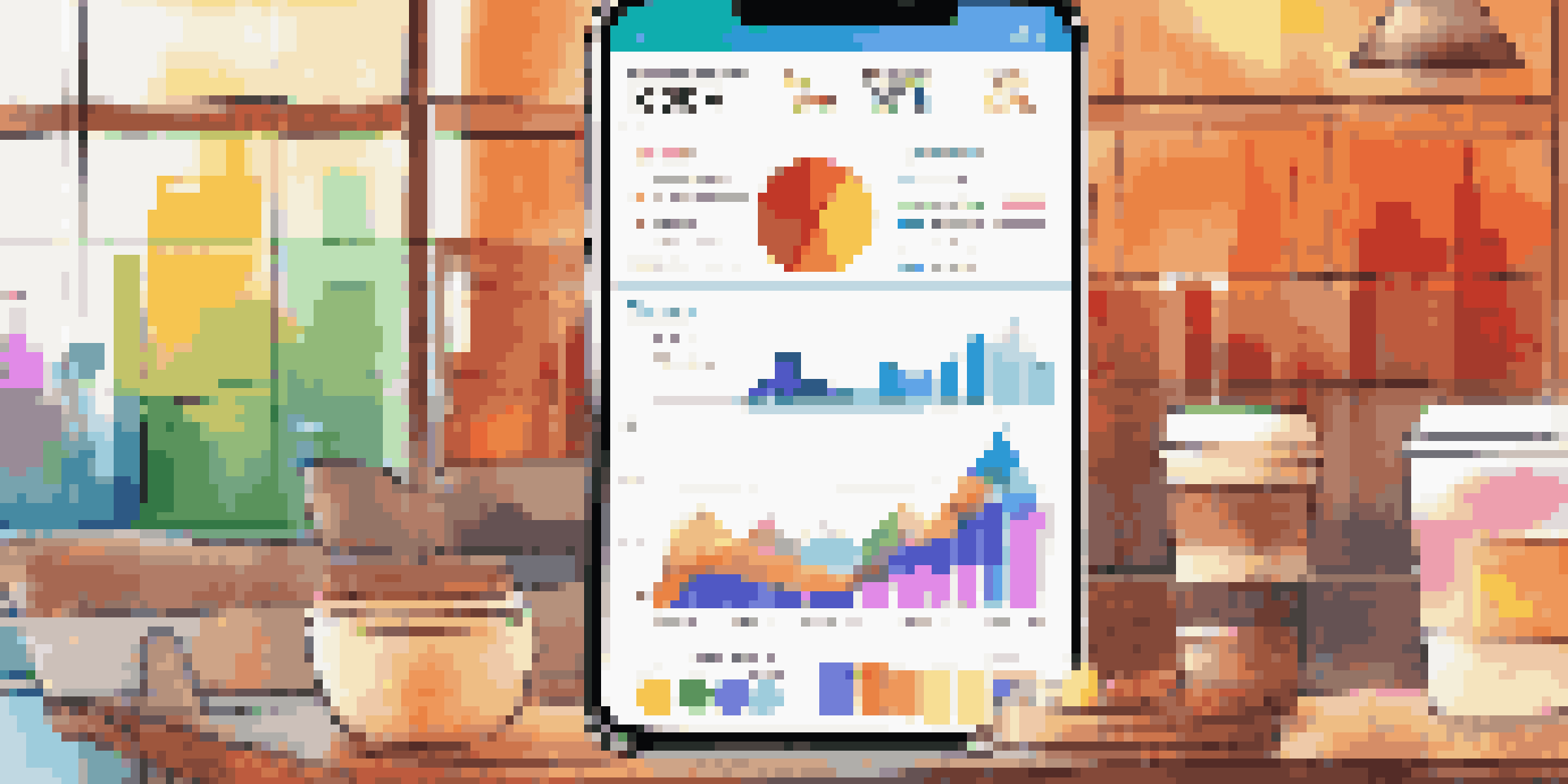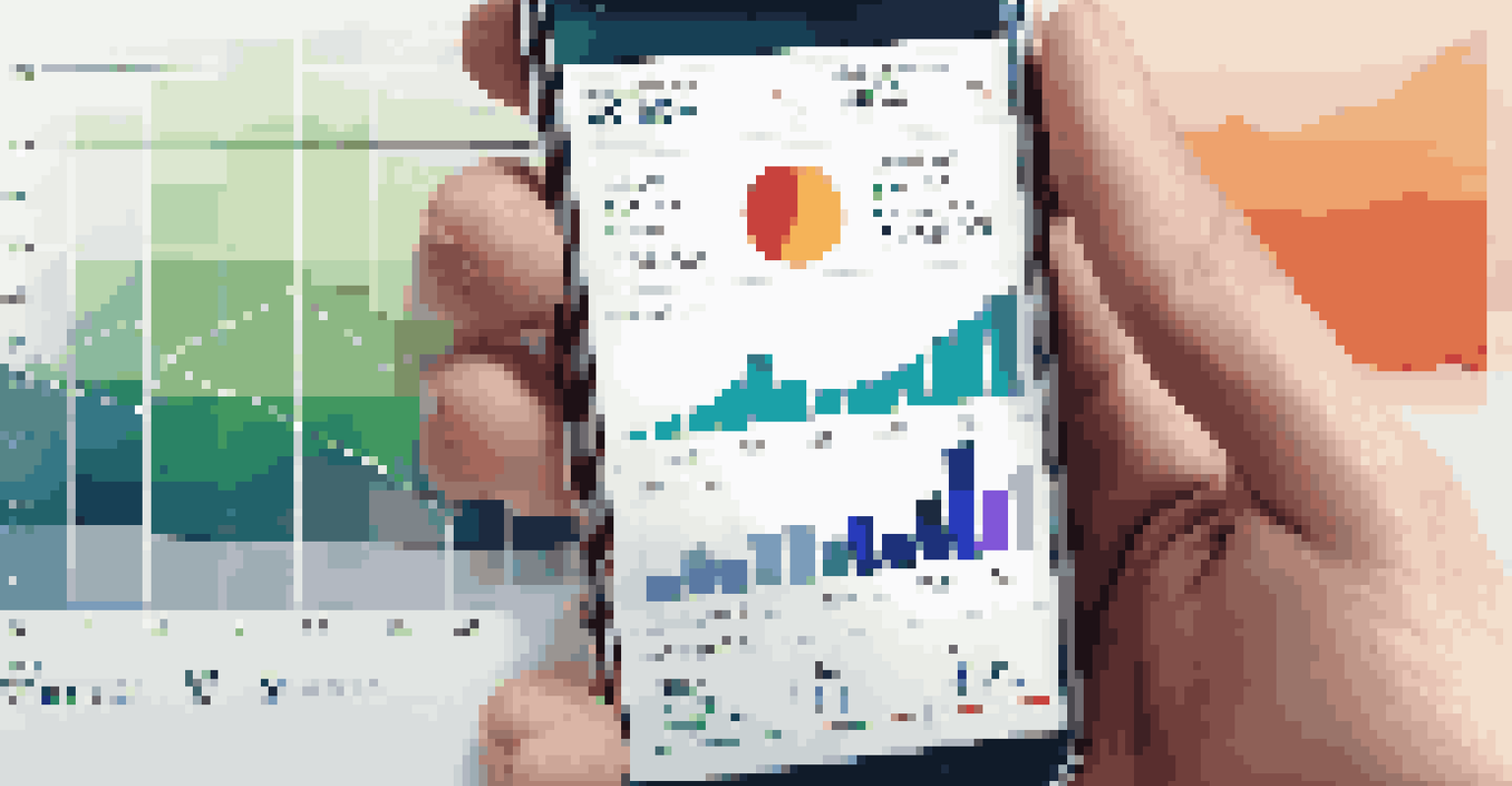The Rise of Mobile Data Visualization Applications

Understanding Mobile Data Visualization Applications
Mobile data visualization applications are tools that help users interpret complex data on their mobile devices. These apps convert raw data into visual formats like charts and graphs, making it easier for individuals to digest information quickly. Imagine trying to read a dense report filled with numbers; now picture that same data represented in a colorful pie chart. This transformation not only makes data more accessible but also enhances our ability to make informed decisions.
Data is the new oil.
The rise of smartphones and tablets has significantly contributed to the popularity of these applications. With the ability to carry powerful computing tools in our pockets, the demand for mobile-friendly solutions has skyrocketed. Users want to analyze data on the go, whether they are in a meeting, commuting, or enjoying a coffee break. This shift has opened doors to innovative applications that cater specifically to mobile users.
Moreover, the integration of mobile data visualization into everyday tasks is becoming the norm. From business professionals tracking sales figures to students analyzing research data, these applications serve a diverse audience. As we continue to rely on data in various aspects of our lives, mobile data visualization apps are set to play an even more significant role in how we understand and interact with information.
The Benefits of Mobile Data Visualization for Users
One of the primary benefits of mobile data visualization applications is their ability to simplify complex information. Users can quickly grasp trends and patterns that might be obscured in raw data. For instance, a sales manager can visualize monthly performance metrics through a simple dashboard, enabling faster decision-making. This ease of understanding is crucial in today’s fast-paced environment where time is of the essence.

Another significant advantage is the accessibility these apps provide. With mobile data visualization, users can access important insights anywhere, anytime. Whether you’re at your desk or on the go, having the ability to interact with data instantly empowers users to stay informed. This level of accessibility fosters a culture of data-driven decision-making in both personal and professional contexts.
Mobile Apps Make Data Accessible
Mobile data visualization applications simplify complex information, enabling users to analyze and understand data easily on the go.
Additionally, many of these applications offer real-time data updates, which keeps users informed of the most current information. Imagine a business analyst receiving instant updates on market trends while attending a conference. Such capabilities allow for timely responses to changing situations, making mobile data visualization not just a convenience, but a crucial component of strategic planning.
Key Features to Look for in Mobile Data Visualization Apps
When selecting a mobile data visualization application, it’s essential to consider user-friendliness. An intuitive interface allows users of all skill levels to navigate the app with ease. If a tool is too complicated, it can defeat the purpose of making data accessible. Look for applications that prioritize simplicity without compromising on functionality.
Without data, you’re just another person with an opinion.
Another important feature is customization. The best mobile data visualization apps allow users to tailor visual representations to their specific needs. This could mean adjusting color schemes, selecting preferred chart types, or filtering data for focused analysis. Customization ensures that the information resonates with users, making it more relevant and easier to understand.
Lastly, ensure that the application supports data integration from various sources. Whether it’s spreadsheets, cloud storage, or databases, the ability to pull in data seamlessly makes the app much more versatile. Users can consolidate information from multiple channels, creating a comprehensive view that enhances their overall understanding.
Popular Mobile Data Visualization Applications Today
Several mobile data visualization applications have gained popularity due to their robust features and user-friendly designs. Apps like Tableau and Microsoft Power BI offer powerful visualization tools that cater to both individual users and teams. These platforms allow users to create compelling visual stories with their data, turning numbers into narratives that can influence decisions.
Another noteworthy mention is Google Data Studio, which provides an accessible way for users to visualize data from various Google services. Its integration with tools like Google Analytics and Google Sheets makes it a favorite among marketers and analysts alike. Users appreciate the ability to create shareable reports that can be accessed on any device, enhancing collaboration and transparency.
AI Enhances Data Visualization Tools
Artificial Intelligence automates data analysis and personalizes user experiences, making mobile data visualization more intuitive and effective.
For those looking for a more straightforward approach, apps like Infogram and Datawrapper provide easy-to-use interfaces for creating infographics and charts. These tools are ideal for users who may not have extensive data analysis backgrounds but still want to present information visually. With a few clicks, anyone can transform data into eye-catching visuals that engage their audience.
The Role of AI in Mobile Data Visualization
Artificial Intelligence (AI) is revolutionizing mobile data visualization applications by automating complex tasks. AI algorithms can analyze vast amounts of data and identify trends that might not be immediately obvious to users. This capability allows the applications to suggest the best ways to visualize data, enabling users to make more informed decisions without needing extensive expertise.
Moreover, AI can enhance user experience by personalizing the content presented in the app. By learning user preferences and behaviors, AI can recommend specific datasets or visualizations that align with individual needs. This level of personalization makes data exploration more relevant and engaging, effectively turning the app into a tailored analytical assistant.
AI-driven mobile data visualization also supports predictive analytics, allowing users to forecast future trends based on historical data. For example, a retail manager could use predictive insights to anticipate sales spikes during holiday seasons. By leveraging AI, users can not only visualize past performance but also plan strategically for what lies ahead.
Challenges and Limitations of Mobile Data Visualization Apps
While mobile data visualization applications offer many advantages, there are also challenges users should be aware of. One notable limitation is screen size; while mobile devices are incredibly powerful, they can make it difficult to view complex datasets in detail. This can lead to oversimplification of data, which might result in important insights being overlooked.
Data security is another concern that users must consider. Many mobile applications require access to sensitive information, which raises questions about data privacy and protection. Organizations must ensure they use apps that comply with security standards and best practices to safeguard their data. Users should always check for encryption and secure login features when choosing an application.
Future Trends in Data Visualization
The future of mobile data visualization will see advancements like augmented reality and increased user-friendly features, broadening access to data insights.
Additionally, the variety of mobile devices and operating systems can lead to inconsistencies in app performance. Some applications may work seamlessly on one platform but struggle on another. This fragmentation can frustrate users and hinder their ability to access crucial data when needed. Developers are continually working to address these issues, but they remain a consideration for potential users.
The Future of Mobile Data Visualization Applications
The future of mobile data visualization applications looks promising, with ongoing advancements in technology. As mobile devices become even more powerful, we can expect apps to incorporate more sophisticated features and capabilities. Enhanced graphics, augmented reality (AR), and virtual reality (VR) integrations may become part of the mobile data visualization landscape, creating immersive experiences for users.
Moreover, as the importance of data literacy grows, we can anticipate a surge in demand for user-friendly applications. Developers will likely focus on making these tools accessible to a broader audience, including those without technical backgrounds. This democratization of data visualization could empower more individuals to harness the power of data in their everyday lives.

Lastly, the integration of AI and machine learning will continue to play a critical role in the evolution of mobile data visualization applications. By providing deeper insights and predictive capabilities, these technologies will enable users to make smarter, data-driven decisions. As we look ahead, the fusion of creativity and technology in mobile applications promises to reshape how we visualize and interact with data.